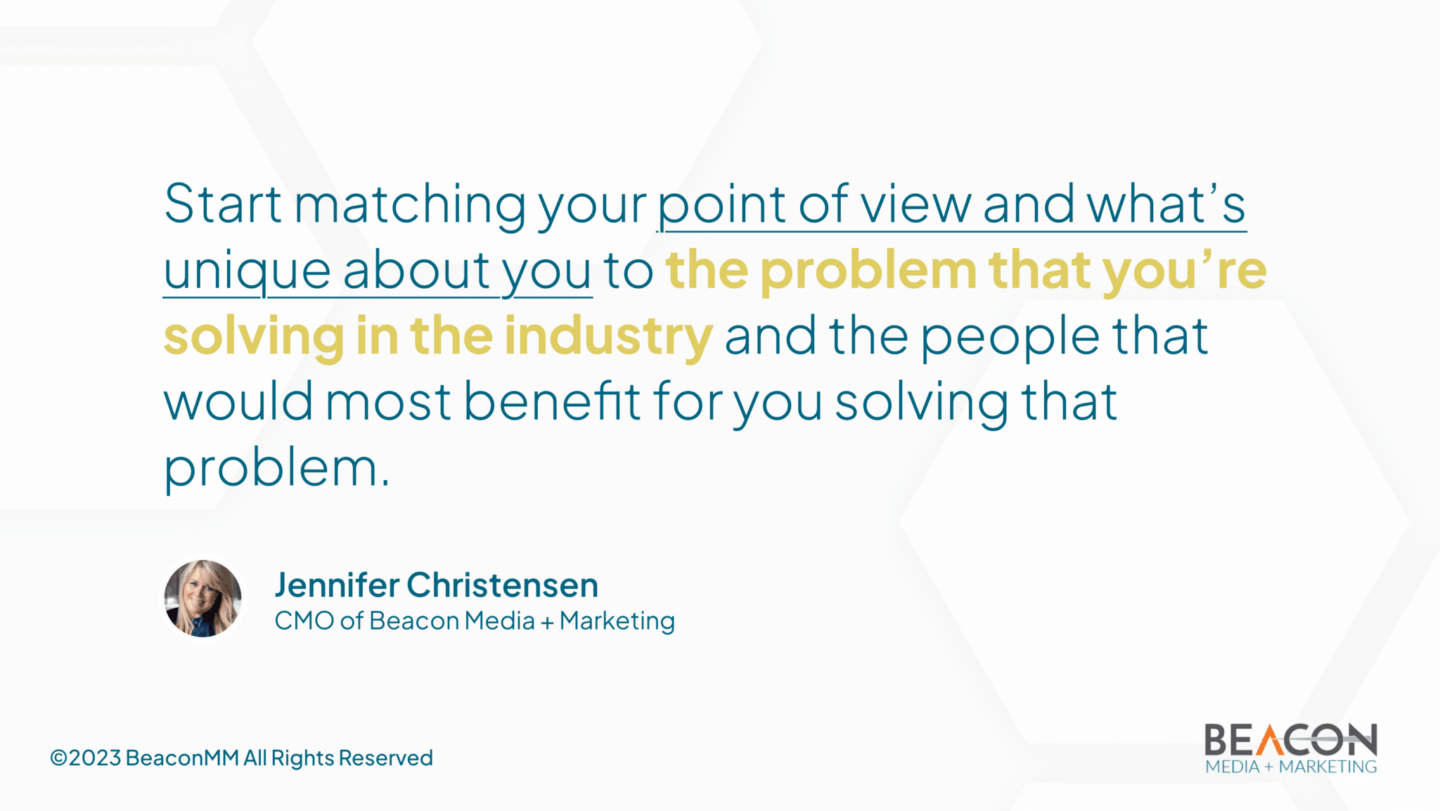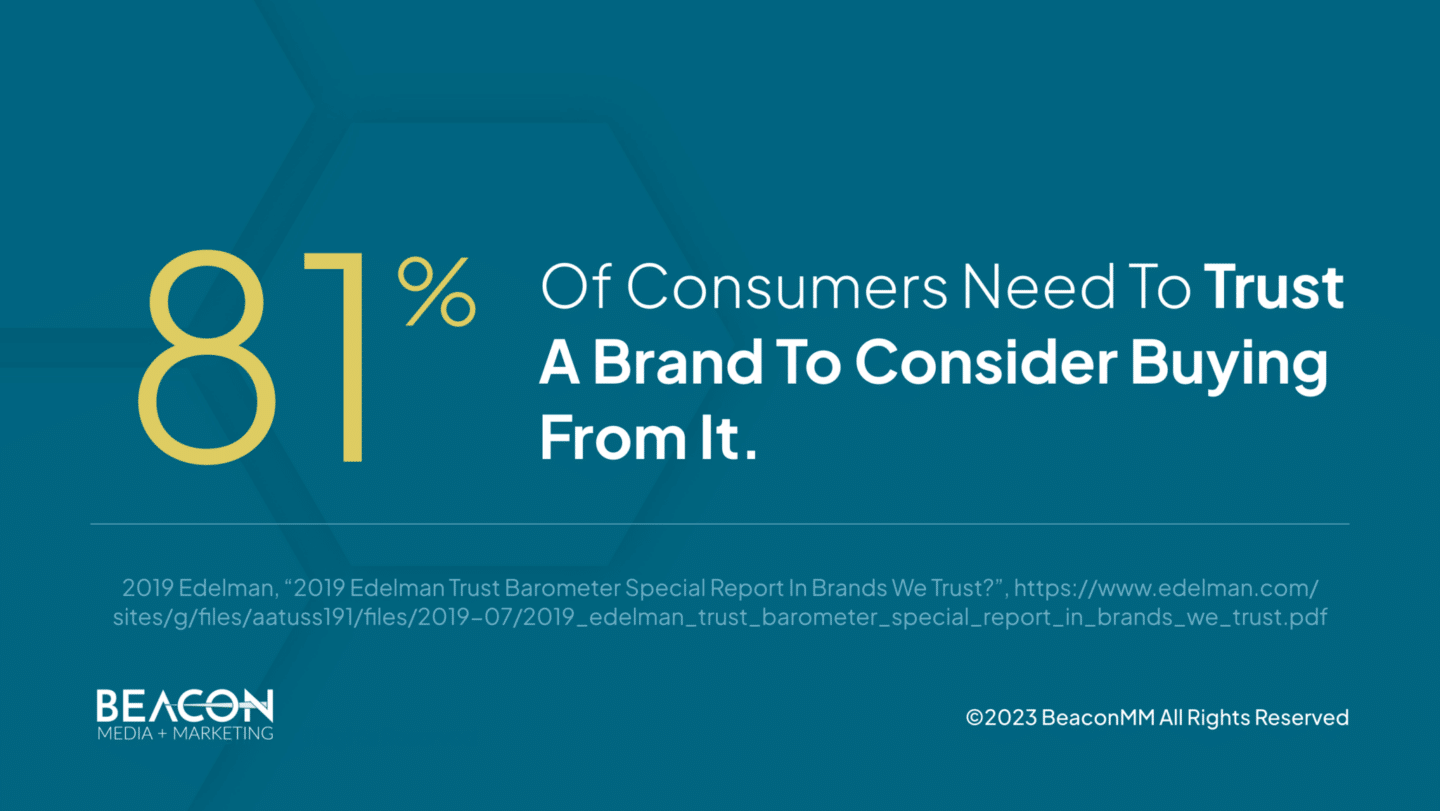Unleashing The Power of Brand Messaging and Refining Your Niche Markets

Crafting Your Brand Messaging and Identifying Your Audience
Clearly articulated brand messaging is foundational to the rest of your marketing strategy and identification of your target audience are important steps in this process. Most businesses stop with the client profile, at Beacon Media + Marketing, we dig much deeper than that.
In Episode 8, Part 1 of Brand Messaging, we explained how discovering who you are (and are not) in your business is pivotal to the beginning of your marketing strategy. Discovering who you are not allows who you are to really shine.
Once you have established your brand identity, you can dive into discovering who your niche market is and what kind of client is going to resonate with you — even exploring all the way down into the micro details of which personality profiles will complement you and your business best.
For solo entrepreneurs or smaller businesses, analyzing personality styles that you work best with (like Promoter or Empath) can increase your chance of success with smoother collaborations. This may seem a bit like a touchy-feely approach, however, personality conflicts are prevalent in every area of life. These considerations are important in business and help minimize conflict while maximizing good working relationships.
Identify and Solve Frustrating Issues Facing Your Industry
Consider your point of view on the problems you are solving in your niche business or industry. How does that relate to the frustrations and issues that your target audience is struggling with? If even 5% of people have these same issues, who is going to relate to them?
For instance, an HVAC company that has cutting-edge technology to offer which allows its customers to remotely monitor their homes when they are traveling. The target audience for that is a demographic that does a lot of travel are tech-enthusiasts, and people who value being able to track their homes while they’re away. When you start focusing on aligning your point of view with what’s unique about you and the problem you’re solving, you enhance your reach to that specific target audience.
Knowing your target audience allows you to shape and craft your point of view so your services reach that client. A dentist who wants to reach a targeted audience that has a need for emergency services, flexible payments, and Saturday appointments, can effectively shape their point of view to reach that target market with unique offerings.
These are high-level examples; both are effective strategies to identify and reach the ideal market you want to target. According to Business Network International, “People don’t like to be sold but they love to buy, and they want to buy from somebody they know, like, and trust.” Developing your target audience through profiling has developed a bad reputation, however, we feel that by profiling your ideal customer or client you can connect your passion and your unique position in the business world with the target audience you desire to serve. This also means that your target audience is less likely, if at all, susceptible to feeling as if they are being sold. Instead, you are presenting them with an opportunity to purchase from somebody that they know, like, and trust because you are meeting them where they are.

Understanding Your Ideal Client on a Deeper Level: Developing Your Niche Market
Taking the time to develop your target audience and meet them where they are, helps you understand them at a deeper level which allows you to align them with your passion. When your target audience trusts you, fewer barriers exist in connecting with those people. This does not mean that you can’t serve clients outside of the ideal customer base profile, it simply means that the ones who are in that ideal client base will usually be the most profitable versus those who are not. Niching down will provide good clientele and does not eliminate as many clients as you may think.
It is important to overcome the myth that by narrowing down your message to one or two target audiences, you’ll alienate everyone else. Instead, focus on the importance of crafting a true message that reflects you. There will always be people outside of your target audience that will resonate with other elements of that messaging while an over-broad message runs the risk of missing the market altogether due to confusion about your offerings.
If the thought of niching down at this level terrifies you, you are not alone. It took Beacon Media + Marketing several years to fully commit to this idea even though each time we would stick our toes in the water to try a niched-down campaign we received great results. Despite the positive outcomes, Beacon Media + Marketing was slow to implement this concept company-wide. Beacon’s owners knew in the beginning that it was destined to niche into being a digital agency, but the courage to turn away from a traditional agency profile took some time to develop. Our origin story tells of how we evolved and decided to double down and make it or not by becoming true to who we knew we should be.
In Depth Digging to Profile Your Niche
It may seem unnecessary to dig down into the minutia of the details of your target audience, but when we talk about profiling, we mean profiling. We suggest going as far as even picking a name for the person you’ve profiled and pondering all aspects of their life that make them whom you imagine them to be.
Beacon’s primary niche is mental health, but we serve other niches as well. We have different target audiences for these markets and run different campaigns for these different niche markets.
When working with our primary niche (mental health), we have three primary profiles, and we tailor our marketing to them. We go so far as to say, for example, “This is Bob. He is the clinic director of XYZ Mental Health Clinic who has five different providers working for him. He has a background in mental health and has now decided to take it to a bigger level.” We continue to be curious about his life, and speculate is he married, what could his wife’s name be, what his family unit consists of, how many children he has, and what phase of life they are in. We also want to know what his leisure activities would be, we speculate about what are his hobbies when he isn’t working, maybe he plays golf or is a guy who likes to fly and has his pilot’s license. Answering these allows us to understand our target audience and resonate with them in a more effective way.
It’s important to build this profile deep so that you can really understand your target audience. This is especially true in the digital space because there are so many opportunities to meet that target audience member when they are not working or out enjoying a leisure activity. Reaching them in a place they are already interested in is a way to build trust. This creates a connection well outside of business, it shows that we know about them and that we see them for who they are. Showing value for people and not just profit by deepening relationships and connections is a new level of operations. It tells people that you care for their humanity and not the monetary worth of their business.
Politics and religion can be tricky in our society, instead, we advise that you focus on shared interests and passions that can open doors for authentic connections. Reaching them with a message of “I see you; I know you love XYZ and we have a solution for you” receives a better reaction than “You should come to buy our stuff because you need it and we’re amazing.” These approaches will elicit very different responses from each other. If you can engage with them in their happy place and authentically connect where they are already committed, it’s a big win.
The Importance of Maintaining Authenticity to Reaching Your Target Audience
To effectively communicate, the connection must be authentic; it must be real and match authentically with your brand. If it doesn’t, then your communication will seem manipulative and disingenuous. People pick up on that type of communication and you risk alienating your audience.
Going deep into this is critical and helpful to order to advance your business and meet the right people. Episode 8 of our podcast — The Beacon Way — was about knowing who you are and knowing what your story is. When you know what you are for and what you are against, you will know if you are operating authentically for your brand. To learn more about this, see The Beacon Way: Brand Messaging Part 1.
Tapping Into Pain Points to Reach Your Target Audience
When launching your business, it’s common to be inspired to do so because of pain points in your industry. Your client profile must consider how they are experiencing these pain points. The core cause of these pain points have symptoms that you can address and going beyond that symptom to the core to gain an understanding of them is crucial. Uncovering the underlying problem your client is facing and addressing that issue will bring much greater and long-term success. Begin the assessment by asking yourself a few questions about why they are frustrated and where is the anxiety coming from. This will show you the pain points you want to address.
The process of analyzing the motivation to begin your business, understanding who you are and who you are not, then getting into the core of your target audience’s pain points will allow you to move your business into the authentic messaging that will captivate the clients you are looking for. Narrow messaging does not mean narrow sales, it means that you are providing clarity of the services you offer and the clientele who will benefit the most from your unique services.
Utilizing Feedback to Refine Your Marketing Strategy
You’re growing your business and helping clients, now you have an opportunity to interview your clients and get feedback from them. Feedback is a great way to analyze if you have hit the mark with your client or if adjustments need to be made. Take the time to find out from your clients if you are hitting their pain points. Ask them if they are experiencing problems that you don’t know about. Are you solving those problems?
It is easy to fall into the trap of thinking that now you’ve got them you can move on to the next one. Your clients are your best focus group and are usually willing to tell you the truth. Taking the time to ask questions allows you to continue to deepen the relationship with those clients and refine your business strategies for them and also for your business.
Stay Ahead of the Market: Research, Research, Research
Marketing is a rapidly evolving business, and it is imperative that you stay on top of trends in the industry as well as research what technology clients are using and want to use based on what others are doing within these industries.
We suggest that you research industry experts to see where they are moving and what they are saying. Research will allow you to make adjustments to your business and move it forward in areas that others have been slow to adapt to. If you are an innovator, take what your are seeing as an industry trend and ask yourself how you can implement this into your next phase of operations.
Client feedback can also help you decide where and when you need to shift and implement. Client pain points will show you if you are offering services that will allow you to keep solving their problems. These sorts of shifts and changes can have a dramatic impact on your business. Beacon moved into social media, PPC, and pay-per-click based on client feedback and their pain points. They told us the problems we needed to solve and by being responsive to those things, the clients feel like they are part of the process and this helps you get better and better in your niche to be a problem solver.
This can be an intimidating process because we are not all Kellogg’s with millions of dollars to find focus groups to ask questions to. Calling your clients and asking questions takes courage and will get you the information you need. Your clients can also be an asset in this process because they can refer you to others who also have good input to add. Interviewing other businesspeople, or business owners, even if they are not your clients, can provide valuable information that you have never heard before. Focus groups don’t have to be intimidating or gargantuan to yield valuable results.
Wherever you are in this process, we encourage you to dig deep into your target audience profiles and ask tough questions to futher your ability to serve your current client base. If you are building your client base, ask friends and family or ask for referrals from whom you have talked to. Be brave in this process, we are sure the results will help you shape and focus your way into a more successful partnership with all your clients.
For more information on Brand Messaging, check out The Beacon Way Podcast anywhere podcasts can be found.






